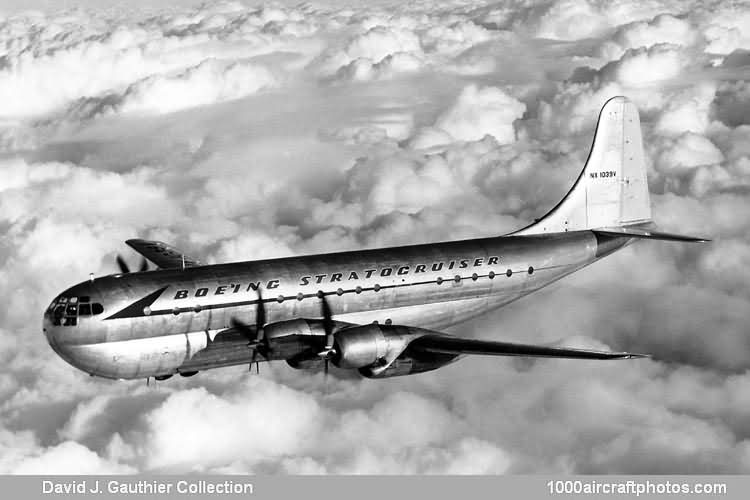03/31/2012. Remarks by Johan Visschedijk: "The 377 series was a commercial development of the military Model 367 C-97 series, and used the structure and engines of the YC-97A and on. Named Stratocruiser by Boeing, the postwar airliner had passenger accommodation, window arrangement, and entry doors similar to those of the YC-97B.
Depending on seating density and arrangement, the main passenger cabin could seat from 55 to 100 passengers. When equipped as a sleeper aircraft, the 377 contained 28 upper and lower berth units plus five seats. A spiral staircase led to a lounge on the lower deck behind the wing that could hold an additional14 passengers. This was generally used as a luxury bar by the air-lines and seating space in it was not sold or used to increase overall capacity. Complete dressing rooms were provided for both men and women, and the most complete galley provided to that time in a commercial airliner was installed at the rear of the cabin. The number of cabin attendants varied, but the flight crew consisted of pilot, co-pilot, navigator, engineer, and radio operator.
Before the first Stratocruiser was completed, Boeing released artists' drawings made from XC-97 photos to publicize the new airliner. This paper aircraft carried the fictional registration NC47377, which identified it as the Model 377 much in the manner that Stratoliner NX19906 had been briefly renumbered NX1940 to publicize 'The 1940 Airliner'.
Although the 377s delivered to six customer airlines were structurally the same and carried the same TC 812, they differed considerably in interior appointments. This caused Boeing to assign a variation of the basic model number to each airline, a practice that was to continue into jet transport production. All Stratocruisers were delivered between February 1949, and March 1950.
Model 377-10-19. The prototype Stratocruiser, registered NX90700, was known to factory personnel as No. 11 because it followed the 10th plane of the YC-97 contract (YC-97B) on the production line. This first commercial model was a Boeing-owned aircraft for most of the testing toward certification of the 377 series under ATC 812.
The fact that it was called 'Dog Ship' was no reflection on its characteristics. The expression is a long-established flight test term, going back almost to WW I, used to designate a prototype or developmental model that undergoes all the experimental changes, carries the test equipment in a stripped interior, and generally gets kicked around. First flight of the 377-10-19 was on July 8, 1947. It was bought in stripped condition by Pan American Airways and was modified up to 377-10-26 standard in the airline shops and given the new registration N1022V.
Model 377-10-26. Pan American Airways placed the original and the largest order for Stratocruisers, twenty of the 55 built. One PAA Stratocruiser, NX1039V (pictured above), was flown originally in Boeing markings and used as a second prototype in the certification program. The airline bought the factory-owned 377-10-19 prototype and modified it to 377-10-26, then obtained the six American Overseas 377-10-20s by merger for a fleet total of 27 before selling one 377-10-26 to BOAC.
Ten 377-10-26s used by PAA's Atlantic Division were modified to Super Stratocruisers by installation of tanks for an additional 450 gal (2,046 l) of fuel to permit non-stop flights from New York to London or Paris. Original fuel capacity was 7,790 gal (35,413 l). All 27 were later fitted with new turbo-superchargers. Most of the PAA Stratocruisers became Boeing property in 1958-1959 when they were traded in for new Model 707 jet transports.
Model 377-10-28. Four Stratocruisers were ordered by the combined Swedish, Norwegian, and Danish airlines now known as Scandinavian Airlines System, or SAS. Two were given Swedish registration and one each Norwegian and Danish. Interior appointments were extra deluxe and were different for each aeroplane. All were acquired by BOAC before flying under SAS colours and three were sold in 1958 to Transocean Airlines, which had its headquarters in Oakland, California.
Model 377-10-29. Eight Stratocruisers were ordered by American Overseas Airlines (AOA), the transatlantic subsidiary of American Airlines (AA). Although flown in AOA markings, these machines were taken over by PAA when AOA was merged with PAA.
Model 377-10-30. Northwest Airlines (NWA) took delivery of ten Stratocruisers that differed in outward appearance from the others in that the windows were rectangular instead of circular. After a period of service, the airline changed the appearance still more by adding a C-97A-type weather radome to the nose. After nearly ten years of service, these aircraft were traded-in to Lockheed Aircraft Corp. for new turboprop Lockheed Electras and Lockheed disposed of some of them to Aero Space Lines for eventual conversion to B-377PG Pregnant Guppy's.
Model 377-10-32. Only the first six of what was eventually to become a seventeen-Stratocruiser fleet for BOAC were ordered from the factory, all others being taken over from other airlines. The original six and four others were sold to Transocean Airlines of Oakland, California, in 1958 to make way for newer jet transports.
Model 377-10-34. United Air Lines (UAL) ordered seven Stratocruisers with rectangular windows similar to the NWA 377-10-30s, and used them for service to Hawaii and within the continental United States, the only airline to do so. After relatively short service, six were sold to BOAC."
